11 Tips To Keep In Mind For The Best Tasting Risotto
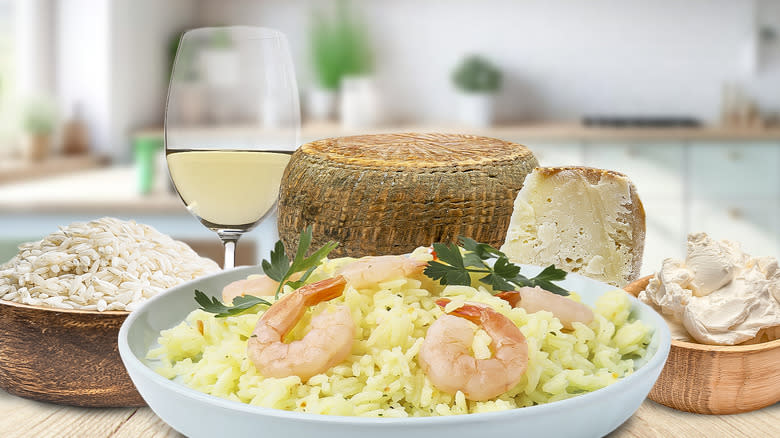
The ultimate in Italian comfort food, risotto is a dish that most of us love to eat, but many of us are hesitant to make at home. The prospect of making a risotto from scratch, adding the stock slowly and stirring constantly, can be daunting if you have never attempted it before.
To give you the best chance of creating a risotto that Nonna herself would be proud of, I spoke to Tommaso Iorio, Italian chef and ambassador at Rovagnati, to find out what goes into making the authentic Italian version. From choosing the best rice to learning how quickly to add the stock, chef Iorio shares his expert tips to help you create a restaurant quality risotto at home, whether you are an experienced home cook or are just starting to dabble in the kitchen. So grab your best stirring spoon — you're going to need it — and join us as we explore the tips to keep in mind for the best tasting risotto.
Read more: 26 Types Of Pasta Sauce Explained
Consider Carnaroli Rice As Well As Arborio

When it comes to making the perfect risotto, you have to get one thing right before you start — the type of rice. You can't use plain white rice and expect to get a delicious Italian risotto and Arborio rice is the one many home cooks opt for. However, chef Tommaso Iorio suggests there are two good options to consider.
"In Italy, for example, the two major varieties that chefs often debate over are Arborio and Carnaroli. Personally, I prefer the latter. It's a bit like asking if we prefer a Ferrari or a Lamborghini," he jokes. "Both are great."
Though Arborio rice is more widely available in the States, Carnaroli is known as the king of risotto rice, since its higher starch content leads to a creamier dish. "It is crucial to use one of these varieties because they have been selected over time specifically to create splendid risottos," Iorio says. "For instance, Carnaroli has a grain that doesn't overcook and holds its texture, maintaining an al dente core."
Since serving it al dente is a crucial part of a perfect risotto, Carnaroli rice should be on your grocery list if you're aiming to make the ultimate Italian dish. If you can't get a hold of it, however, Arborio will more than suffice, especially if you follow the rest of chef Iorio's expert tips.
Use The Correct Pan
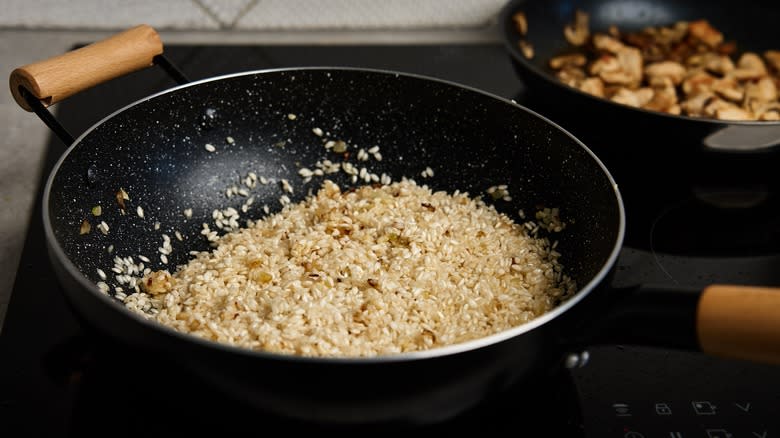
Once you have chosen the best rice for your risotto, the next challenge is finding the ideal pan to cook it in. Risotto is a labor of love, and choosing the correct pan will make the task more enjoyable, rather than risking your precious rice sticking together or burning onto the bottom of the pan.
Chef Tommaso Iorio warns not to use the same pan as you would for another Italian staple — pasta. "First and foremost, avoid using a narrow, high-sided pot like those used for boiling pasta. This can lead to uneven cooking: The grains at the bottom may stick together, while those on top remain undercooked."
Instead, use a wide pan so the rice can cook in an even layer. Cast iron, stainless steel, and non-stick pans can all be used, depending on what you have available. "The ideal size of the pan depends on the amount of risotto you plan to make: For six people, for example, a 12 inches diameter pan works well," advises Iorio. "You can opt for a pan with two handles or a wide skillet, preferably with flared sides and a height of no more than 10 inches."
If you make a lot of risotto, consider purchasing a pan specially for this dish, that will help make every plate perfect. Whether cooking a romantic meal for two or impressing your extended family, using the right pan will mean your risotto won't disappoint.
Toast The Rice Before You Add The Stock
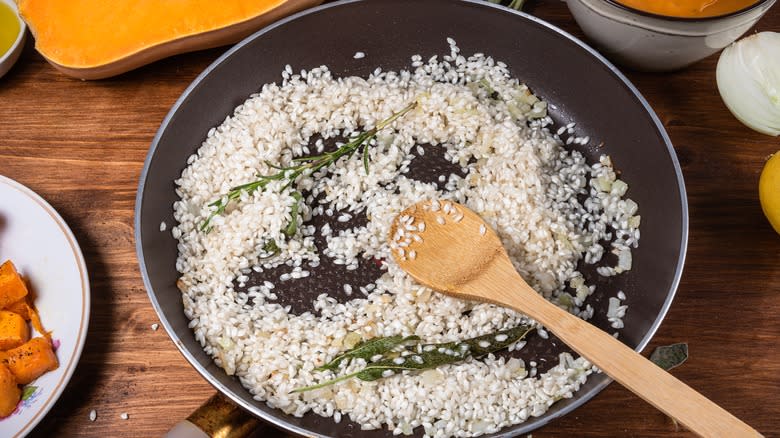
Once you've got your Arborio or Carnaroli rice, it's time to focus on turning it in to that gorgeous, silky risotto. One of the crucial first steps is to toast the rice in the pan before you add any liquid to it. Chef Tommaso Iorio advises not to miss out this step in a hurry to get your risotto cooked.
"Toasting is one of the key steps in preparing risotto, which for us Italians is almost a ritual," he says. "By toasting the rice before adding the broth, you seal the outer walls of the grains, preventing them from breaking down during cooking and making the risotto too soft and sticky."
After cooking your base of onions or shallots in oil, add the rice without any additional liquid, mix it thoroughly with the onions, and cook for around four minutes. The texture of the rice in a risotto is crucial, and chef Iorio points out that toasting it will help create the correct consistency.
"Essentially, we want the risotto to avoid becoming sushi rice," he says. "Instead, we want it to retain its grain, shape, and texture." Toasting the rice may seem like an unnecessary step, but it is anything but. By giving your rice a little time in the pan without the stock, you will be setting yourself up for a beautifully cooked risotto with a luxurious texture.
Deglaze With Wine, But Not Too Much
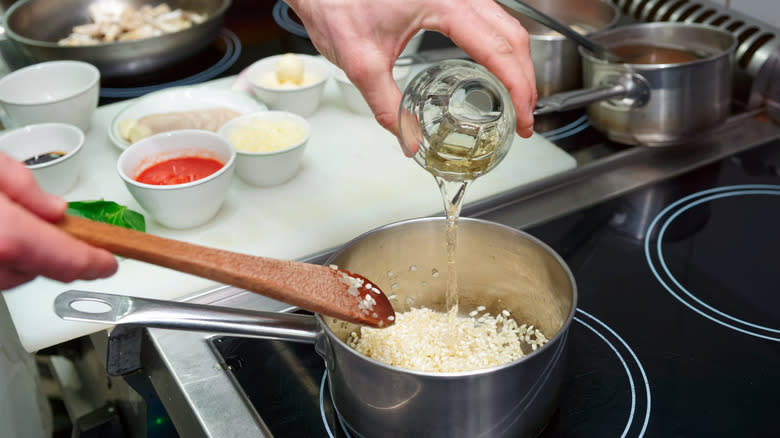
With your rice toasted and on its way to risotto perfection, the next step is deglazing the pan, which means adding liquid to get little bits of flavor that might be stuck to the bottom of the pan, and mixing them with the rice. Italians most commonly use white wine to deglaze risotto.
"Wine is one of the essential ingredients for preparing risotto. It's important to note that only a small amount should be used; its role is merely to add flavor," Chef Tommaso Iorio said. "It should be added right before the broth, immediately after toasting the rice, so that most of the alcohol evaporates, leaving the flavors clinging to the grains."
If you don't have any wine, Iorio says you can always add another type of alcohol, even though it is not the classic Italian option. "There are also recipes where other types of alcohol can be used instead of wine, such as beer, vodka, or Champagne, each adding a unique flavor profile to the risotto."
If you don't want to add alcohol to your dish, you can still deglaze the pan without the addition of booze. "To omit the wine, we can use a small amount of quality vinegar instead (being careful not to use too much, as it could make the risotto too acidic), said Iorio. "Alternatively, you can skip the wine and go straight to adding the broth. Trust me, you'll still end up with a delicious risotto."
Add The Broth Little By Little
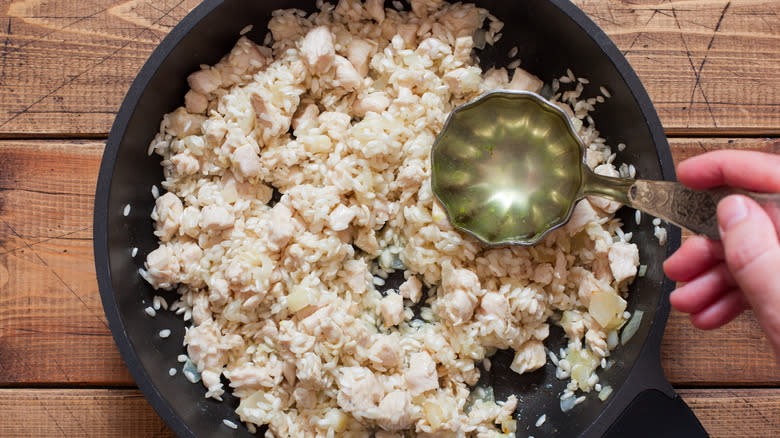
One step that frustrates home cooks new to cooking risotto is the time you need to spend adding the stock a little at a time, waiting for it to be absorbed, then adding some more. Chef Tommaso Iorio told us he is often asked during cooking classes why the broth for the risotto has to be added in small quantities.
"Wouldn't it be easier to add all the broth at once? The answer is that adding the broth gradually allows the rice to release its starches slowly, creating the creamy texture characteristic of a good risotto," he said. "It also ensures that the rice cooks evenly, with each addition of broth being absorbed fully before adding more, resulting in a perfectly cooked dish."
The key to making risotto properly is patience -- adding a small amount of broth, stirring to encourage the release of starch, then repeating the process again. You can't rush this part if you want your risotto to be a success.
"It's important to add the broth a little at a time because, by cooking the risotto with a small amount of liquid at a specific temperature, the rice releases starch, creating the creaminess needed for a perfect risotto," explained Iorio. " Additionally, adding the broth gradually allows us to monitor the cooking process more accurately. Remember, risotto cooks by absorbing the broth or water. If you add it all at once, you risk adding too little or too much liquid."
Cook It Al Dente
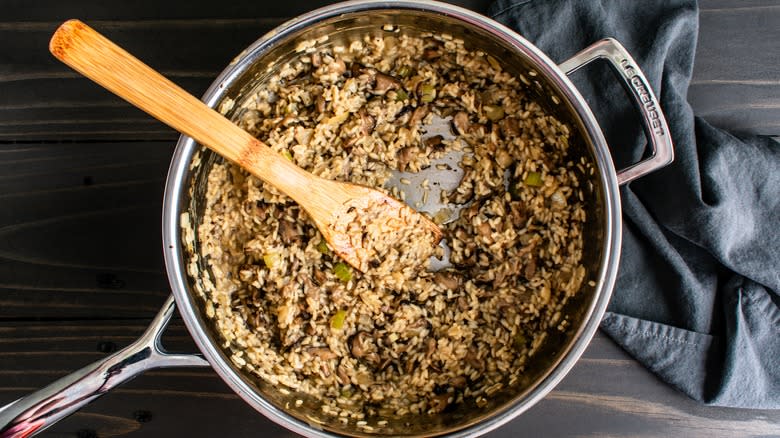
Though it may be time consuming, the main task when cooking a risotto of adding the broth in small quantities and stirring constantly is straightforward. As long as you have the patience to allow the rice to absorb the stock each time, there is not much that can go wrong. However, the trick is knowing when to stop to prevent the risotto from overcooking.
"It's important to remember that everyone cooks risotto to their preferred level of doneness," says Iorio. "The only rule we have in the kitchen is to cook what makes you happy. However, a traditional risotto is usually cooked al dente."
Literally meaning "to the tooth", al dente is the term used to describe food that has been cooked so that it still has a firm texture without being mushy. This can be tricky to master, but the key is to taste constantly as you make your risotto — once it has overcooked, there is no going back. When the risotto is undercooked, you will feel the solid center of the rice as you bite into it, which will be unpleasant. As the cooking progresses and the rice soaks up the broth, you will notice the rice start to soften, until it is soft with a firm bite in the middle. "You can tell it's ready when it creates the famous "wave," meaning that when you move it in the pan, it forms a wave due to the achieved creamy consistency," he added.
Be Creative With Your Ingredients

Once you have mastered the basic risotto Milanese — the simplest of risottos, named after Milan where its creator, chef Felice Luraschi was from — you can start to be creative with your ingredients and add a punch of flavor and color. A traditional risotto Milanese contains saffron to give it a beautiful golden color, but apart from that, consists of only the basic risotto ingredients.
Chef Tommaso Iorio like to use classic Italian ingredients that he knows will work well in the dish. "Among my favorite risottos are saffron risotto, porcini mushroom risotto, and truffle risotto," he says.
Beyond these classic Italian flavors, you can customize your risotto to suit whatever produce you have in the house, or what you are in the mood for. Butternut squash risotto is a great option, filled with fiber and antioxidants from the squash, which caramelizes beautifully as it cooks. If you're looking for a more filling dish with extra protein, try a salmon risotto with lemony notes to keep the flavor fresh.
Always Use High-Quality Ingredients
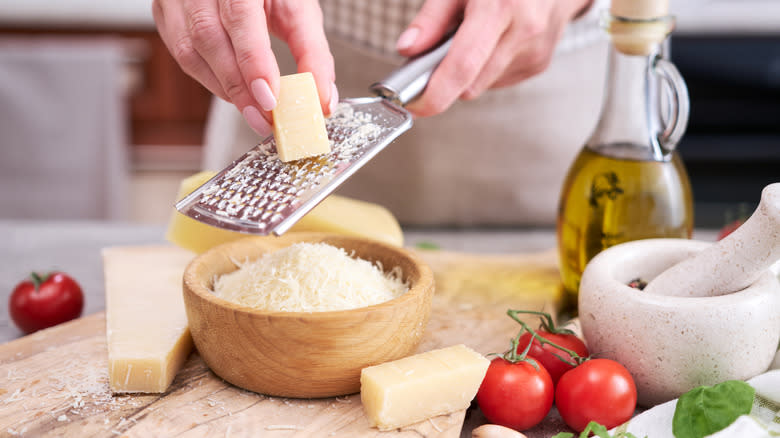
One reason that Italian cuisine is beloved worldwide is its use of simple ingredients to make delicious dishes. To make this work, however, the quality of produce is key — in a recipe with only three or four ingredients, each one has to shine. The same applies to making your own risotto — if you want it to match the Italian classic, you have to buy high-quality ingredients. For your rice, choose a well-known Italian brand such as Acquerello, that is known for its superior quality.
Chef Tommaso Iorio chooses high-quality ingredients where possible, including authentic Italian produce. "I love using Parmigiano Reggiano or Grana Padano. Nothing against Parmesan made in the USA, but try these, and you'll agree with me," he said. "I also love to use high-quality unsalted butter, and sometimes, instead of butter, I use mascarpone."
If you are adding vegetables to your risotto, fresh San Marzano tomatoes will give it an authentic Italian flavor, too. Chef Iorio also has a surprising suggestion for a twist on the usual savory version — add some sweet berries to it. "For Valentine's Day, I also recommend trying strawberry risotto," he suggests. This unusual combo was popular in the 1980s and combines sweet and salty notes perfectly. No matter what type of risotto you are creating, just use the highest-quality produce you can find, and your dish will benefit as a result.
Embrace The Time It Takes To Make Risotto
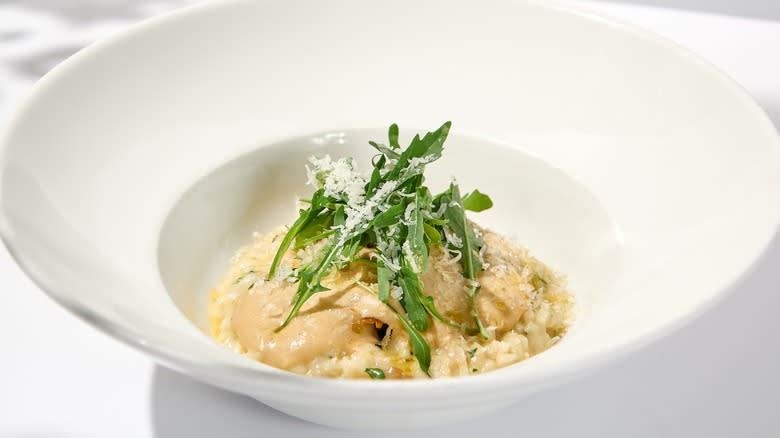
In our modern age of new technology in the kitchen, there are many cooks who recommend using slow cookers or pressure cookers to make dishes like risotto, taking the hard work and time spent standing at the stove out, to free you up to do other things. While you can technically make a risotto this way, the result will not be the same in terms of both texture and flavor, and Chef Tommaso Iorio is not a fan of making the classic dish this way.
"I recognize that sometimes we are in a hurry and might want to cook risotto more quickly," he acknowledges. "However, the very essence of risotto is time and companionship. For my family, for example, cooking risotto is like a ceremony. My mother cooks with us, sipping a good glass of Prosecco, asking us how our day went while we help her and stir the risotto. So when it comes to risotto, time is a must because it requires constant attention."
If you are short of time or don't have the energy to stand in front of the cooker, chef Iorio recommends making something else instead, and saving risotto for when you are able to commit to it. "Risotto is delicate, and for all the reasons mentioned earlier, it needs to be cooked slowly and with care. Therefore, I recommend choosing to make risotto only when you have the time or good company for dinner."
Don't Skip The Mantecatura
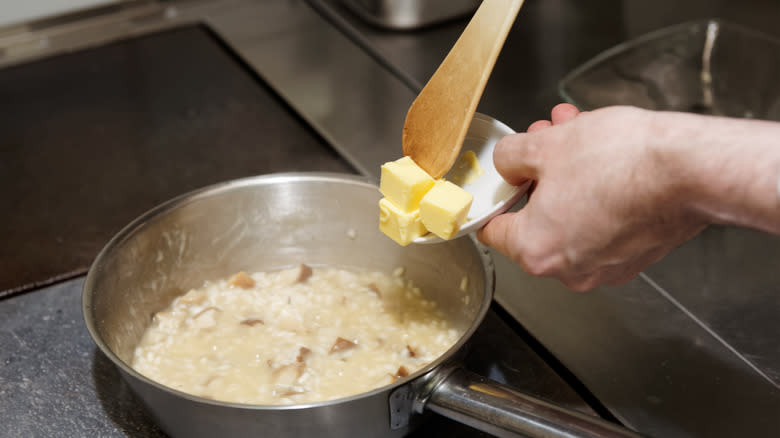
Unless you are a risotto aficionado — or a professional chef — there is a good chance you will not have heard of the final step in creating the perfect risotto. And according to chef Tommaso Iorio, missing this step out is not an option.
"Let's remember, risotto is a fantastic dish that can be made with almost anything, from seasonal vegetables to simple ingredients," he said. "Always use high-quality ingredients. But the most important tip? The final stirring, or 'mantecatura.'"
The word mantecatura comes from the Italian verb mantecare, which means stirring or whisking something to make it creamy. In risotto making, it refers to the last step of the process, where cheese and butter are stirred vigorously into the rice, transforming the dish from a fairly brothy rice dish to a luxurious, silky treat. "When your risotto reaches the desired doneness, turn off the heat and, still in the cooking pot, stir in Parmigiano and butter. This will elevate your risotto," Iorio explained. "But always remember, do this with the heat off. It's a must."
Turning the heat off before the mantecatura avoids overcooking the butter and cheese, as they will melt and continue to cook with the residual heat from the dish. This last step of the cooking process may be difficult to pronounce, but it will give your risotto the perfect shine that will make it look and taste fantastic.
Add Plenty Of Cheese — Then Add Some More!
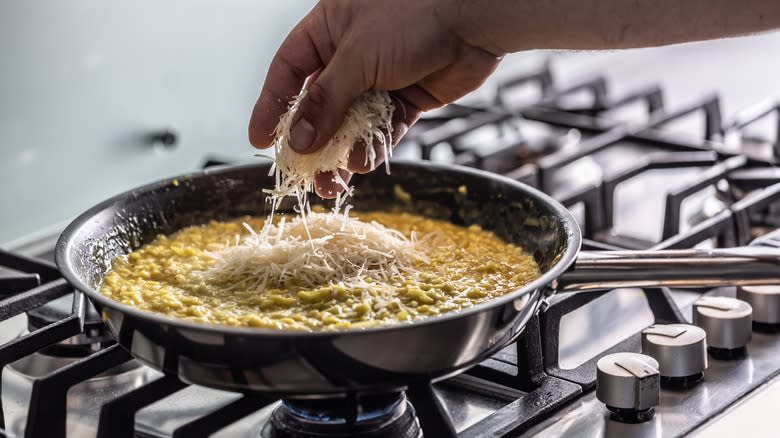
Once you have completed the cooking of your superstar risotto, there is only one thing left to do — plate it up and serve it to your guests. The very last step in making your risotto look and taste sublime is to add cheese — and lots of it.
Chef Tommaso Iorio told us how to finish off your risotto in true Italian style. "Plate your risotto and finish with more Parmigiano. As my grandmother says, cheese is like love — never enough."
When Iorio says Parmigiano, he is of course referring to fresh Parmigiano Reggiano from northern Italy. Never use the dried, extremely pungent cheese that comes in a plastic shaker — that cheese has no business being on the same plate as your masterpiece. Buy high-quality Parmesan if you can. It may be expensive, but remember due to its strong umami flavor, a little goes a long way. The cheese should be grated onto the risotto as part of the mantecatura step, and then again after plating. As you serve the dish to your guests, it should just have started to melt, creating a visually beautiful risotto that can't fail to impress them.
Read the original article on Tasting Table.


